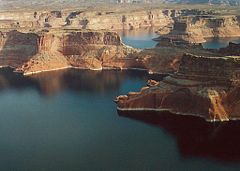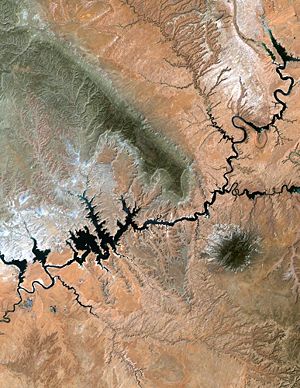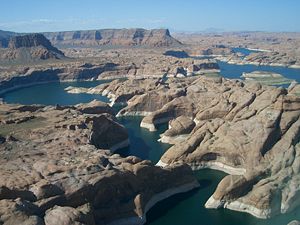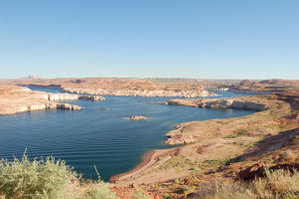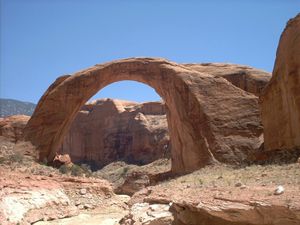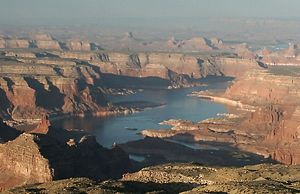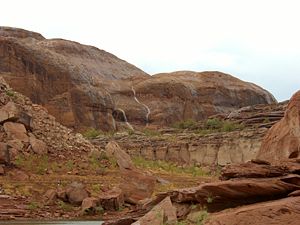Lake Powell
2008/9 Schools Wikipedia Selection. Related subjects: Geography
| Lake Powell | |
|---|---|
| Location | Utah/ Arizona |
| Coordinates | |
| Lake type | reservoir |
| Primary inflows | Colorado River, Escalante River, San Juan River |
| Primary outflows | Colorado River |
| Catchment area | 67,000 km² (26,000 sq mi) |
| Basin countries | United States |
| Max. length | 299 km (186 mi) |
| Max. width | 40 km (25 mi) |
| Surface area | 658 km² (254 sq mi) |
| Average depth | 40 m (132 ft) |
| Max. depth | 170 m (560 ft) |
| Water volume | full: 63 km³ (24 mio acre-feet) current: 30 km³ (13 mio acre-feet) |
| Residence time (of lake water) | 7.2 years |
| Shore length1 | 3,057 km (1,900 mi) |
| Surface elevation | full: 1,127 m (3,700 ft) current: 1,097 m (3,598 ft) |
| 1 Shore length is not a well-defined measure. | |
Lake Powell is a man-made reservoir on the Colorado River, straddling the border between Utah and Arizona. It is the second largest man-made reservoir in the United States behind Lake Mead, storing 24,322,000 acre feet (30 km³) of water when full. Lake Powell was created by the flooding of Glen Canyon by the controversial Glen Canyon Dam, which also led to the creation of Glen Canyon National Recreation Area, a popular summer destination. The reservoir is named for explorer John Wesley Powell, a one-armed American Civil War veteran who explored the river via three wooden boats in 1869. In 1972, Glen Canyon National Recreation Area was established. It is public land managed by the National Park Service, and available to the public for recreational purposes.
Lake Powell is a storage facility for the Upper Basin states of the Colorado River Compact (Colorado, Utah, Wyoming, and New Mexico). The Compact specifies that the Upper Basin states are to provide a minimum annual flow of 8.23 million acre feet (10 km³) to the Lower Basin states (Arizona, Nevada, and California).
History
In the 1940s and early 1950s, the U.S. Bureau of Reclamation planned to construct a series of Colorado River dams in the rugged Colorado Plateau province of Colorado, Utah and Arizona. Glen Canyon Dam was born of a controversial damsite the Bureau selected in Echo Park, in what is now Dinosaur National Monument in Colorado. A small but politically effective group of objectors led by David Brower of the Sierra Club succeeded in defeating the Bureau's bid, citing Echo Park's natural and scenic qualities as too valuable to submerge.
But by agreeing to a relocated damsite near Lee's Ferry, between Glen and Grand Canyons, Brower did not realize what he had gambled away. At the time, Brower had not actually been to Glen Canyon. When he later saw Glen Canyon on a river trip, Brower was stunned to discover that it had the kind of scenic, cultural, and wilderness qualities often associated with America's finest national parks. Over 80 side canyons in the colorful Navajo Sandstone contained clear streams, abundant wildlife, arches, natural bridges, and thousands of Native American archeological sites. By then, however, it was too late to stop the Bureau and its commissioner Floyd Dominy from building Glen Canyon Dam. Dominy was a firm believer in subduing the river for human use, once saying "Now I admit that nature can't improve upon man. We're probably the supreme being." Brower believed the river should remain free, and would forever after consider the loss of Glen Canyon his life's ultimate disappointment.
Construction on Glen Canyon Dam began with a demolition blast keyed by the push of a button by President Dwight D. Eisenhower at his desk in the Oval Office on October 1st, 1956. The first blast started clearing tunnels for water diversion. On February 11th, 1959, water was diverted through the tunnels so dam construction could begin. Later that year, the bridge was completed, allowing trucks to deliver equipment and materials for the dam, and also for the new town of Page, Arizona.
Concrete placement started around the clock on June 17th, 1960. The last bucket of concrete was poured on September 13th, 1963. Over 5 million cubic yards (4,000,000 m³) of concrete make up Glen Canyon Dam. The Dam is 710 feet (216 m) high, with the surface elevation of the water at full pool being approximately 3700 feet (1100 m). Construction of the Dam cost $155 million, and 18 lives were lost in the process. From 1963 to 1966, turbines and generators were installed for hydroelectricity. On September 22nd, 1966, Glen Canyon Dam was dedicated by Lady Bird Johnson.
Upon completion of Glen Canyon Dam on September 13th, 1963, the Colorado River began to back up, no longer being diverted through the tunnels. The newly flooded Glen Canyon formed Lake Powell. It took 17 years for the lake to rise to the high water mark, on June 22nd, 1980. Since then the lake level has fluctuated considerably depending on the seasonal snow runoff from the mountains.
Colorado River flows have been below average since the year 2000, leading to lower lake levels. In the winter of 2005 (before the spring run-off) the lake reached its lowest level since filling, an elevation of 3,550 feet (1,080 m) above sea level, which was approximately 150 feet (46 m) below full pool (elevation 3700'). Since 2005 the lake level has risen 78 feet (24 m), to a high elevation of 3,628 feet (1,106 m) above sea level in spring/early summer 2008. It is estimated this upcoming spring runoff may produce a peak elevation of 3638' during mid-summer 2008.
Geology
Glen Canyon was carved by differential erosion from the Colorado River over an estimated 5 million years. The Colorado Plateau, through which the canyon cuts, arose some 11 million years ago. Within that plateau lie layers of rock from over 300 million years ago to the relatively recent volcanic activity. Pennsylvanian and Permian formations can be seen in Cataract Canyon and San Juan Canyon. The Moenkopi Formation, which dates from 230 million years ago (Triassic Period), and the Chinle Formation are found at Lees Ferry and the Rincon. Both formations are the result of the ancient inland sea that covered the area. Once the sea drained, windblown sand invaded the area, creating what is known as Wingate Sandstone. The more recent (Jurassic Period) formations include Kayenta Sandstone, which produces the trademark blue-black "desert varnish" that streaks down many walls of the canyons. Above this is Navajo Sandstone, the result of more compressed sand dunes. Many of the arches, including Rainbow Bridge, lie at this transition point. This period also includes light yellow Entrada Formations, and the dark brown, almost purple Carmel Formation. These latter two can be seen on the tops of mesas around Wahweap, and the crown of Castle Rock and Tower Butte. Above these layers lie the Straight Cliffs Sandstone and conglomerate shales that make up the Kaiparowits Plateau and San Rafael Swell to the north of the lake.
The confluences of the Escalante River and San Juan River lie within Lake Powell. The slower flow of the San Juan river has produced goosenecks where 5 miles (8.0 km) of river are contained within 1-mile (1.6 km) on a straight line.
Features
The lake's main body stretches up Glen Canyon, but has also filled many (over 90) side canyons. The lake also stretches up the Escalante River and San Juan River where they merge into the main Colorado River. This provides access to many natural geographic points of interest as well as some remnants of the Anasazi culture.
- Rainbow Bridge National Monument
- Defiance House ruin
- Cathedral in the Desert
- San Juan goosenecks
- Kaiparowits Plateau
- Hole-in-the-Rock crossing
- the Rincon
- Three-Roof Ruin
- Padre Bay
- Waterpocket Fold
Development
| Facts | |
|---|---|
| Start of storage | March 13, 1963 |
| Completion of initial filling | June 22, 1980 |
| Surface area | 266 mi² |
Because most of the lake is surrounded by steep sandstone walls, access to the lake is limited to developed marinas:
- Lees Ferry Subdistrict
- Page/ Wahweap Marina
- Antelope Point Marina
- Halls Crossing, Utah Marina
- Bullfrog Marina
- Hite Marina
The following marinas are accessible only by boat:
- Dangling Rope Marina
- Rainbow Bridge National Monument
- Escalante Subdistrict
Glen Canyon National Recreation Area draws more than two million visitors annually. Recreational activities include boating, fishing, waterskiing, jet-skiing, and hiking. Prepared campgrounds can be found at each marina, but many visitors choose to rent a houseboat or bring their own camping equipment, find a secluded spot somewhere in the canyons, and make their own camp (there are no restrictions on where visitors can stay). Anyone who camps further than a quarter of a mile from a marina, however, must bring a porta-potty. The burying of human waste in Glen Canyon National Recreation Area is prohibited. Pet waste must also be packed out.
The southwestern end of Lake Powell in Arizona can be accessed via U.S. Route 89 and State Route 98. State Route 95 and State Route 276 lead to the northeastern end of the lake in Utah.
Fish species
- Largemouth Bass
- Smallmouth Bass
- Striped Bass
- Crappie
- Sunfish
- Catfish (Channel)
- Northern Pike
- Walleye
